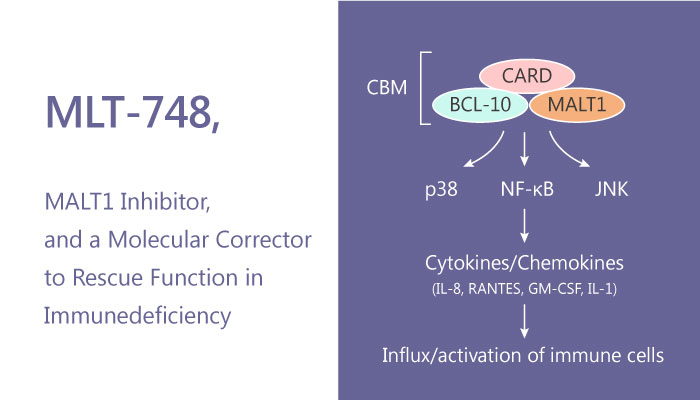
In previous blog “MLT-747, an Allosteric MALT1 Inhibitor for Immunodeficiency Research”, we introduced MLT-747 as a potent, selective, allosteric inhibitor of MALT1, which could rescue function in an immune deficient patient.
And in the same article, there was another potent, selective and allosteric inhibitor of MALT1 MLT-748, binds MALT1 in the allosteric Trp580 pocket, with an IC50 value of 5 nM.
You all may have a question, what is the difference between MLT-748 and MLT-747?
Firstly, both MLT-748 and MLT-747 are two closely related allosteric inhibitors of MALT1 with nanomolar potency. Additionally, they adopt a similar pose via binding at the interface between the caspase and immunoglobulin (Ig3) domains by displacing Trp580 and locking the catalytic site in an inactive state. Indeed, MLT-748 and MLT-747 bind at the same site as mepazine and thioridazine.
Differently, in the study, MLT-748 reversibly bound to human mutant MALT1 (329-728)-W580S (Kd, 13 nM) with affinity similar to that of the wild type MALT1 (329-728). In MALT1mut/mut patient immortalized B cells, MLT-748 (0-2 μM) stabilized cellular MALT1-W580S, with an EC50 of 69 nM. In addition, MLT-748 (2 µM, 24 hours) treatment increased the phosphorylation of p65 and IκBα in MALT1mut/mut patient immortalized B cells.
The concentration of 1 μM MLT-748 completely blocked cleavage of the MALT1 substrates BCL10, HOIL1, CYLD, and RelB. Additionally, the effect continued at all-time points after cell stimulation in primary normal human CD3+ T cells. However, MLT-748 had only mild effects on phosphorylation of IκBα during cell stimulation of these normal T cells. And it did inhibit T cell antigen receptor downstream signaling.
To conclude, MLT-748 is a clinical candidate drug in the use of immunedeficiency.